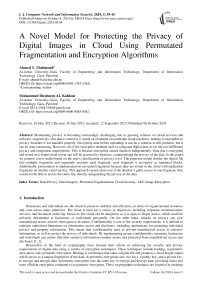A Novel Model for Protecting the Privacy of Digital Images in Cloud Using Permutated Fragmentation and Encryption Algorithms
Автор: Ahmed Y. Mahmoud, Mohammed Ibraheem AL Kahlout
Журнал: International Journal of Computer Network and Information Security @ijcnis
Статья в выпуске: 5 vol.16, 2024 года.
Бесплатный доступ
Maintaining privacy is becoming increasingly challenging due to growing reliance on cloud services and software, respectively. Our data is stored in a virtual environment on unreliable cloud machines, making it susceptible to privacy breaches if not handled properly. Encrypting data before uploading it can be a solution to this problem, but it can be time-consuming. However, all of the encryption methods used to safeguard digital data so far did not fulfillment privacy and integration requirements. This is because encryption cannot function independently. Data that is encrypted and stored on a single cloud server can still be accessed by attackers, compromising the privacy of the data. In this paper, we propose a new model based on the user's classification of privacy level. The proposed model divides the digital file into multiple fragments and separately encrypts each fragment; each fragment is encrypted as separated blocks. Additionally, permutation is implemented on encrypted fragments because they are stored in the cloud with replication fragments on another cloud service. This approach ensures that even if the attacker’s gains access to one fragment, they would not be able to access the entire file, thereby safeguarding the privacy of the data.
Data Privacy, Data Integrity, Permuted Fragmentation, Cloud Security, AES, Image Encryption
Короткий адрес: https://sciup.org/15019472
IDR: 15019472 | DOI: 10.5815/ijcnis.2024.05.04
Список литературы A Novel Model for Protecting the Privacy of Digital Images in Cloud Using Permutated Fragmentation and Encryption Algorithms
- Mogull, Rich, James Arlen, Francoise Gilbert, Adrian Lane, David Mortman, Gunnar Peterson, and Mike Rothman. “Security-Guidance-v4-FINAL.” Available at https://www.cliffsnotes.com/file/188846316/security-guidance-v4-FINAL-feb27-18docx/ last access date 25, April 2023
- Giraldo, J., Sarkar, E., Cardenas, A. A., Maniatakos, M., & Kantarcioglu, M. Security and privacy in cyber-physical systems: A survey of surveys. IEEE Design & Test, 34(4), 2017, pp. 7-17.
- Ahmed Y. Mahmoud, Alexander G. Chefranov, "A Hill Cipher Modification Based on Eigenvalues Extension with Dynamic Key Size HCM-EXDKS", International Journal of Computer Network and Information Security, vol.6, no.5, pp.57-65, 2014.
- Ahmed Y. Mahmoud, "A Novel Hash Functions for Data Integrity Based on Affine Hill Cipher and Tensor Product," International Journal of Engineering Trends and Technology, vol. 70, no. 11, pp. 1-9, 2022. Crossref, https://doi.org/10.14445/22315381/IJETT-V70I11P201
- A. G. Mahmoud, A. Y., & Chefranov, “Secure Hill cipher modifications and key exchange protocol,” 2010 IEEE Int. Conf. Autom. Qual. Testing, Robot., vol. 2, pp. 1–6, 2010.
- A. Mahmoud and A. Chefranov, “Hill cipher modification based on pseudo-random eigenvalues,” Appl. Math. Inf. Sci., vol. 8, no. 2, pp. 505–516, 2014, doi: 10.12785/amis/080208.
- Mahmoud, A. Y., & Chefranov, A. G. Secure hill cipher modification based on generalized permutation matrix SHC-GPM. Information Sciences Letters, 2012, pp. 91-102.
- A. Y. Mahmoud and M. M. Abu-Saqer, “Modification of select operation model for multilevel security: Medical database systems as an application,” Proc. - 2020 Int. Conf. Assist. Rehabil. Technol. iCareTech 2020, pp. 47–50, 2020, doi: 10.1109/iCareTech49914.2020.00016.
- Mahmoud, A. Y., & Chefranov, A. G. Hill cipher modification based on eigenvalues hcm-EE. In Proceedings of the 2nd international conference on Security of information and networks pp. 164-167. October, 2009.
- A. Y. Mahmoud and M. N. A. Alqumboz, “Encryption based on multilevel security for relational database EBMSR,” Proc. - 2019 Int. Conf. Promis. Electron. Technol. ICPET 2019, pp. 130–135, 2019, doi: 10.1109/ICPET.2019.00031.
- Mahmoud, A. Y., & Abu-Saqer, M. M. Modifications of An Encrypted-Based Sql Models for Multilevel Database. Journal of Theoretical and Applied Information Technology, 2022, 100(17).
- Khobragade, S., Bhosale, R., & Jiwane, R. High security mechanism: fragmentation and replication in the cloud with auto update in the system. Computer Science and Information Technologies, 1(2), 2020, pp. 78-83.
- Broumandnia, A. The 3D modular chaotic map to digital color image encryption. Future Generation Computer Systems, 99, 2019, pp. 489-499.
- Salunkhe, S. D., & Patil, D. (2016, August). Division and replication for data with public auditing scheme for cloud storage. In 2016 International Conference on Computing Communication Control and automation (ICCUBEA) - Pune, India (pp. 1-5). IEEE.
- Santos, N., Lentini, S., Grosso, E., Ghita, B., & Masala, G. Performance analysis of data fragmentation techniques on a cloud server. International Journal of Grid and Utility Computing, 10(4), 2019, pp. 392-401.
- Sajay, K. R., Babu, S. S., & Vijayalakshmi, Y. Enhancing the security of cloud data using hybrid encryption algorithm. Journal of Ambient Intelligence and Humanized Computing, 2019, pp. 1-10.
- Rashid, A., & Chaturvedi, A. Cloud computing characteristics and services: a brief review. International Journal of Computer Sciences and Engineering, 7(2), 2019, pp. 421-426.
- Singh, A., Agarwal, P., & Chand, M. Image encryption and analysis using dynamic AES. In 2019 5th International Conference on Optimization and Applications (ICOA) - Kenitra, Morocco (pp. 1-6). IEEE. April 2019.
- Çavuşoğlu, Ü., Kaçar, S., Pehlivan, I., & Zengin, A. Secure image encryption algorithm design using a novel chaos based S-Box. Chaos, Solitons & Fractals, 95, 2017, pp. 92-101.
- Biham, E., & Shamir, A. Differential cryptanalysis of DES-like cryptosystems. Journal of CRYPTOLOGY, 4(1), 1991, pp. 3-72.
- Saidi, R., Cherrid, N., Bentahar, T., Mayache, H., & Bentahar, A. Number of Pixel Change Rate and Unified Average Changing Intensity for Sensitivity Analysis of Encrypted inSAR Interferogram. Ingénierie des Systèmes d Inf., 25(5), 2020, pp. 601-607.


